Start manual matching using the  button from the taskbar, the Manual Matching entry in the Menu or activating the Compare button in the lower right corner. The Adjust/Compare page appears as a three-row layout in the fusion mode as shown below. The first row contains the Reference, the second row a Input series, and the third row the fusion of the two. Note the selection for switching among the Input series. Each of them has its own transformation matrix associated.
button from the taskbar, the Manual Matching entry in the Menu or activating the Compare button in the lower right corner. The Adjust/Compare page appears as a three-row layout in the fusion mode as shown below. The first row contains the Reference, the second row a Input series, and the third row the fusion of the two. Note the selection for switching among the Input series. Each of them has its own transformation matrix associated.
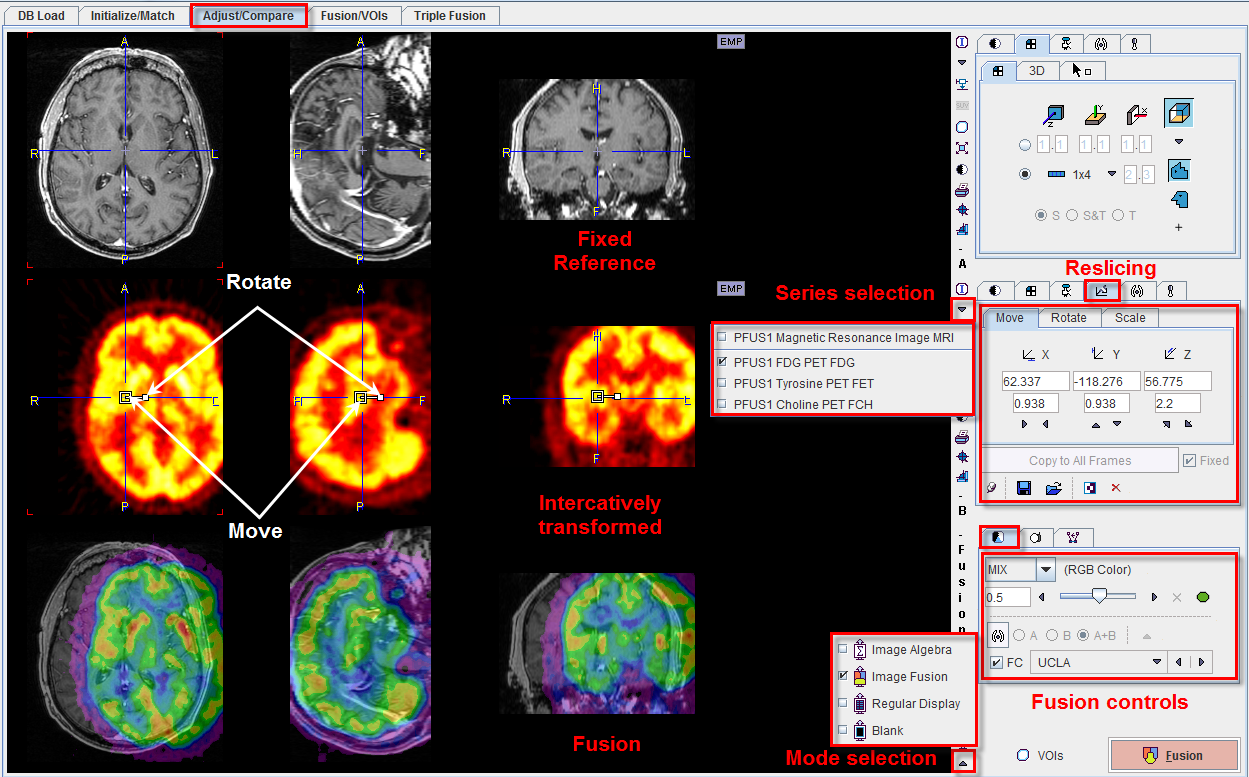
The principle of manual matching is to shift and rotate the Input study in all three directions, until it gets into spatial alignment with the Reference. It is recommended to operate in the orthogonal planes mode (CTRL+D after clicking onto the Reference study, or the corresponding icon in the layout section). To be able to transform the Input study, the reslice mode must be active in the second row. It is enabled by selecting the corresponding  tab in the controls area of the Input study (see above), or pressing CTRL+R after clicking onto the Input study.
tab in the controls area of the Input study (see above), or pressing CTRL+R after clicking onto the Input study.
Summary of Interactive Reslicing
To calculate slices at oblique orientations or rotate images the reslicing pane must be activated. Reslicing is defined by a transformation consisting of translations in all directions, rotations about all axes, and potentially scaling along the axes. Each of these transformation components has its own sub-pane.
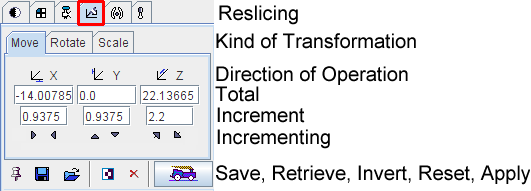
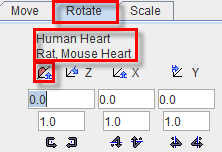
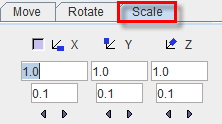
Note that Scale values of 1 indicate that the pixels sizes read from the image header are correct. Any other number will scale the pixel size accordingly.
The transformation parameters can be specified in different ways, on the corresponding sub-panes Move, Rotate, Scale:
In the Rotate tab a help re-orientation button is available for heart studies  . This option button allows re-orienting the heart data such that is closest to the short axis orientation (SA).The heart type can be selected when the button is activated. Two options are available: Human Heart and Rat Mouse Heart.
. This option button allows re-orienting the heart data such that is closest to the short axis orientation (SA).The heart type can be selected when the button is activated. Two options are available: Human Heart and Rat Mouse Heart.
After changing the transformation, new slice images are immediately calculated and shown. However, the entire data set is only generated when needed, for instance to save the images. The ![]() button serves for enforcing the reslicing process for the whole data volume.
button serves for enforcing the reslicing process for the whole data volume.
The  button resets the transformation parameters. A transformation can be saved to disk using
button resets the transformation parameters. A transformation can be saved to disk using ![]() , and later retrieved with
, and later retrieved with ![]() if needed.
if needed.
Important Notes:
1. The facility buttons in the reslicing panel for Save, Retrieve and Apply transformation are not always available.
2. The manual transformations are not fully equivalent with the automatic rigid matching transforms of the fusion tool. Manual transformation can be used in PFUS activating the Load Transformation button in the Auto panel available on the Initialize/Match page. In PFUS, the Inverse transformation is possible to calculate for any type of transformation activating the dedicated button .
.
Mouse-driven Reslicing
As soon as the reslicing pane is activated, handles appear in the image overlay. They allow for interactive, mouse-driven reslicing.
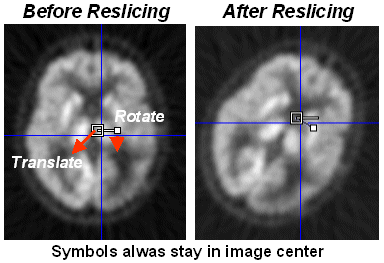
Translation: Move the mouse pointer to the open white rectangle. The cursor changes to  . Click the left mouse button down, and then drag along the direction you want to move the image to.
. Click the left mouse button down, and then drag along the direction you want to move the image to.
Rotation: Move the mouse pointer to the filled small white rectangle. The cursor changes to  . Click the left mouse button down, and then drag while the image gets rotated. To get finer control of rotation, the rectangle can first be dragged radially outward, so that the handle distance from center increases.
. Click the left mouse button down, and then drag while the image gets rotated. To get finer control of rotation, the rectangle can first be dragged radially outward, so that the handle distance from center increases.
Per default, the reslicing handles are shown as long as the reslicing tab is selected. If another tab is selected, they disappear. To make them appear permanently in the images and enable mouse-driven reslicing at all times, the pin button ![]() can be fixed to
can be fixed to ![]() . A quick alternative to show/hide the reslicing controls in the active image is the CTRL+R shortcut.
. A quick alternative to show/hide the reslicing controls in the active image is the CTRL+R shortcut.
In the fusion mode combined information of the upper two rows is shown in the third row. This fusion information should allow the user to check the alignment during interactive matching, so that in the end he can be confident that the found match is satisfactory. There are several ways of fused image rendering, which are explained a lower section.
Selective Frame Alignment of Dynamic Series
Static image series naturally have only one transformation associated with them. For dynamic series, however, PFUS supports one transformation per frame. The automatic Motion correction calculates one transformation per frame with the aim of compensating rigid patient movements throughout the acquisition.
In the Adjust/Match page the user can chose to manually transform all frames at once, or to operate on individual frames. This behavior is controlled by the Reslice all frames box on Matching Initialization pane, in the Initialize/Match page. If the box is checked, all frames are available for transformation. If Reslice all frames is not checked, the user only works with the current frame. When selecting a new frame, he can adjust the transformation without changing that of the prior frame.
However, PFUS supports one transformation per frame. In the Reslicing pane, the user can chose to transform all frames at once, or to operate on individual frames. This behavior is controlled by the Fixed box on the reslicing pane. If Fixed is checked, all frames share the same transformation. If Fixed is not checked, the user only works with the current frame. When selecting a new frame, he can adjust the transformation without changing that of the prior frame. The Copy to All Frames button allows copying an individual transformation to all frames of the series. This function could be used to initially establish an "average" correction of all frames, and then apply fine-tuning for the individual frames.
When a successful automatic transformation is performed for one frame, the transformation matrix can be saved. To apply the same transformation to all frames the Reslice to all frames box needs to be enabled. The Load Transformation button allows loading and applying the individual transformation to all frames of the series. This function could be used to initially establish an "average" correction of all frames, and then apply fine-tuning for the individual frames.